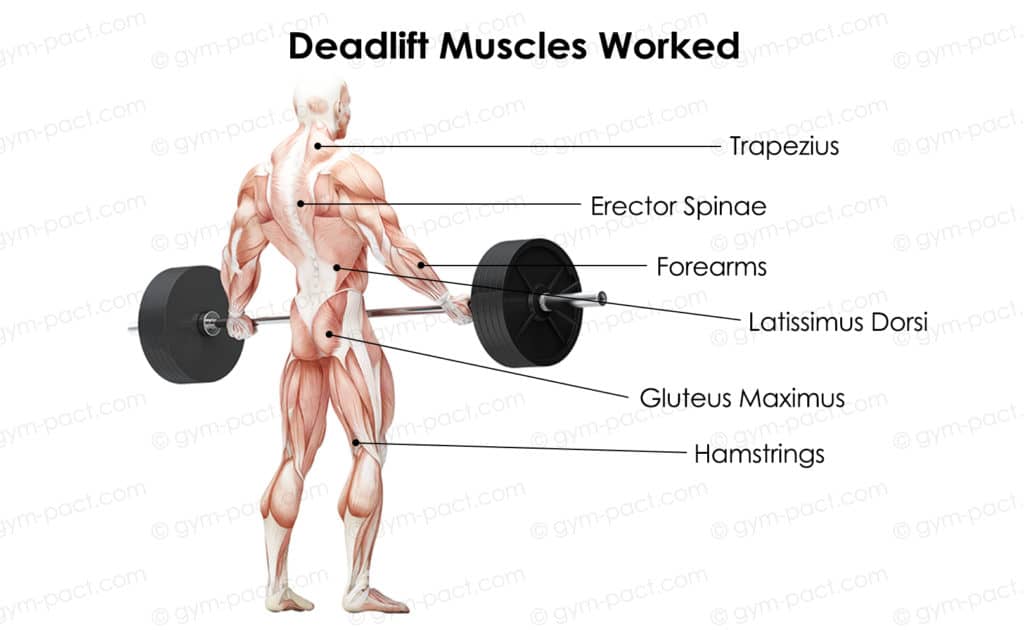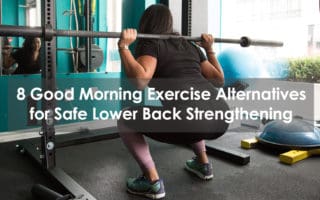The traditional deadlift and the Romanian deadlift are two of a number of versions of this fundamental compound exercise. They are performed to improve overall power while also building muscle and strength through the back, glutes, and hamstrings.
In this article, we compare conventional deadlifts with the Romanian deadlift, so you can decide which version you should use to achieve your specific training goals.
The Deadlift: Muscles Worked, Benefits, How-to, Mistakes to Avoid
Muscles Worked in the Traditional Deadlift

Erector spinae, latissimus dorsi, gluteus maximus, hamstrings, trapezius, forearms
Deadlift Benefits
The deadlift exercise is the ultimate test of overall body muscular strength. It involves every major and minor muscle in the body. The deadlift puts special focus on your posterior chain, making it rare among compound exercises.
By strengthening your erector spinae muscles, your latissimus dorsi, and your glutes, you will make yourself less likely to suffer from the back injuries that are so common in society.
The regular deadlift places special emphasis on the gluteus maximus, or buttocks. This is the largest and, for many people, the weakest muscle in the body. When you make it stronger through deadlifts, your whole body will become more functional.
The deadlift exercise is also one of the best exercises you can perform for forearm and grip strength gains. In addition, works the large muscles of the upper body.
How to Do It
Setting Up:
- Place a loaded Olympic bar on the floor in front of you.
- Position yourself in front of the bar by placing the balls of your feet under the bar. Your toes should be pointed straight ahead or slightly out. Your shins should be close to the bar or touching it. Stand with your feet shoulder-width apart, so that the outside of your leg is at the smooth part where the bar and knurling meet.
- Get into the downward position. Your head should be straight, chest up with a flat back and arms stretched down and reaching for the bar.
- At the initial pull, the hips should be higher than the knees.
- Grab the bar just outside your legs, or grab where the knurling begins and the smooth part of the bar ends.
- Use an alternate grip in which one palm faces forward toward the body and the other faces away. This stabilizes the bar, keeping it close to the body and preventing it from rolling out of your hands.
Beginning the Pull:
- Before starting the pull, take the slack out of the bar by pulling on it through your arms, chest, and shoulders. Remember that the legs and hips, not the arms, are doing the pulling.
- Inhale. Squeeze the bar and push your feet and legs against the floor.
- Raise your hips, shoulders, and chest at the same time as the bar leaves the floor.
- The bar should travel in a straight line. The closer the bar is to the body, the easier the lift.
- Once the bar passes over the knees, push the thighs forward and pull the shoulders up and back until the legs are straight; knees are locked. Arms are straight and shoulders are slightly back. In the top position, you are standing erect.
Lowering the Weight:
- Lower the weight in a controlled manner.
- Flex at the knees and hips, letting the bar travel down the same path it came up.
- Keep the bar close to your body.
- Keep your back flat and keep your head up.
Mistakes to Avoid
- Rolling Your Shoulders – avoid the tendency to roll back your shoulders in the top position as if you were doing a shrug. If you do this, you will automatically thrust your hips forward. Neither of these is good for your form, putting undue strain on your spine.
- Pulling with the arms – do not bend at the elbow or pull with your arms. Proper form will have you focusing on pushing into the floor and using the power of your glutes to get the bar up.
- Doing partial reps – avoid the tendency to only go down partially on the descent. Be sure to set the bar down on the floor between each rep.
- Hips too low – the deadlift should not start in the bottom squat position with your hips way down by the floor. The correct starting hip position is just above the knee level. If you go too low you will effectively shut the hamstrings out of the movement.
- Back rounding – if you round the back when you deadlift, you will overstress the spine. Back rounding may be due to the bar being too far in front of you; make sure that is sitting over your midfoot in the start position. Keep your lower back in a natural arch, tense your lats and pull your shoulder blades back.
- Over-reliance on lifting gear – lifting straps and a weight belt can help when you are going super heavy, but if you rely on them on every set you do, you will rob your body of the ability to get naturally stronger through the forearms and core.
Romanian Deadlift: Muscles Worked, Benefits, How-to, Mistakes to Avoid
Muscles Worked
Gluteus maximus, gluteus medius, hamstrings, spinal erectors, latissimus dorsi, external obliques.
Romanian Deadlift Benefits
The Romanian deadlift allows you to build strength and muscle in the mid posterior chain. It allows you to target the glutes, hamstrings, and spinal erectors with less weight and, therefore, less injury potential than standard deadlifts.
This is also a very useful auxiliary movement to improve your clean and jerk, snatch, and clean pull. It can also help you to get stronger in the glutes, hamstrings, and lower back to allow you to overcome a sticking point when trying to boost your regular deadlift poundages.
How to Do It
Starting Position
- Stand in front of a loaded barbell with your feet hip-width apart and your mid feet under the bar.
- Lower to grab hold of the bar with a slightly wider than shoulder-width overhand grip.
- Come back up to a standing position so that the bar is resting against your thighs at arm’s length. Look straight ahead, with your shoulders back, chest up and lower back neutral.
- Drive your hips back as you lower the bar down your legs to mid-shin level. Allow a slight bend in your knees. Maintain a tight upper back, pull the shoulders back and keep a flat lower back with a natural arch.
- Squeeze the glutes together as your drive your hips forward to return to the start position.
Mistakes to Avoid
- Not pushing your hips back far enough – this is a hamstring and glute-focused exercise and the further you push back your hips, the more emphasis they will get.
- Loose upper back – keep the upper back tight, pulling the shoulders back.
- Rounding the back – maintain a natural arch in your lower back throughout this movement.
Romanian Deadlift vs Deadlift: Which is Better For You?
Each variation of the deadlift has its own purpose and benefits, so it is not possible to categorically state that one is better than the other as it all depends on what your training goal is.
If your goal is overall strength, power, and muscle development then the conventional deadlift is the better option.
If, however, you want to focus the attention on building strength and muscle through the glutes and hamstrings, then the Romanian deadlift is the way to go.
The Romanian version will place less strain on your lower back, making it the better option for people who already have a weakness in this area. It is also a better option to improve hip mobility.
Performing the Romanian deadlift as a supplementary exercise will help you to get stronger in both the standard deadlift and the squat.
Conclusion
The deadlift is a fundamental compound movement that should be foundational to every weightlifting routine.
The key difference between the standard and Romanian versions of the movement is that the former works the entire body whereas the latter focuses on the glutes, hamstrings, and lower back.
The Romanian deadlift is also a useful supplementary exercise as you are working towards your max deadlift.
Frequently Asked Questions
Is the Romanian deadlift dangerous?
No, the Romanian deadlift is not dangerous so long as it is done with proper form. In fact, because it laces less stress on the spinal erectors and uses less weight, it is comparatively safer than the standard deadlift.
Why is it called a Romanian deadlift?
The Romanian deadlift is named in honor of a Romanian Olympic weightlifter named Nicu Vlad. Vlad won gold at the 1984 Olympics, taking a silver medal four years later and a bronze in 1992. He was known to perform the exercise that would bear his country’s name prior to competition.
Can you deadlift and Romanian deadlift on the same day?
It is not advisable to perform the deadlift and the Romanian deadlift on the same day or in the same workout. Either version is very taxing on your body, requiring time to recuperate and recover. If you perform both versions on the same day, you will not allow your body the time to do this.







